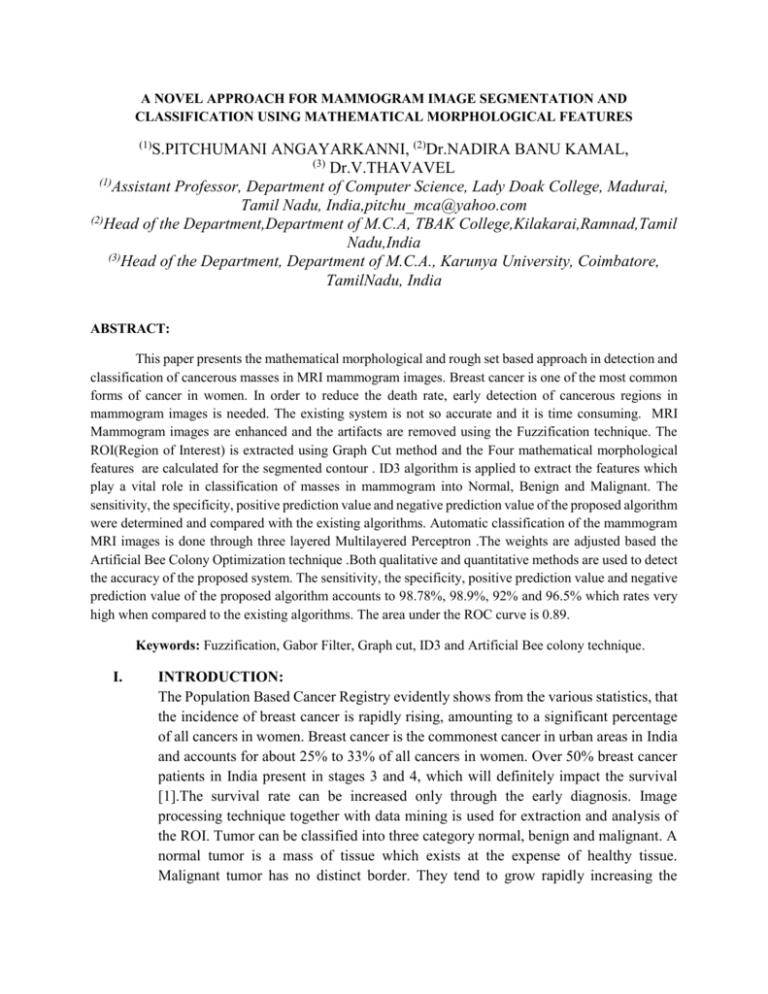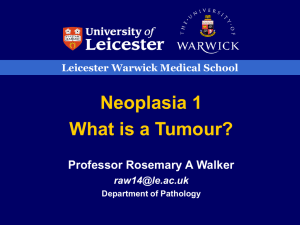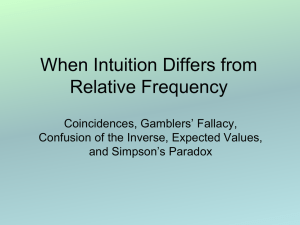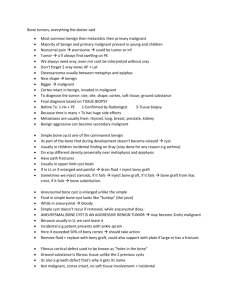This paper presents the mathematical morphological and rough set
advertisement

A NOVEL APPROACH FOR MAMMOGRAM IMAGE SEGMENTATION AND
CLASSIFICATION USING MATHEMATICAL MORPHOLOGICAL FEATURES
(1)
S.PITCHUMANI ANGAYARKANNI, (2)Dr.NADIRA BANU KAMAL,
(3)
Dr.V.THAVAVEL
(1)
Assistant Professor, Department of Computer Science, Lady Doak College, Madurai,
Tamil Nadu, India,pitchu_mca@yahoo.com
(2)
Head of the Department,Department of M.C.A, TBAK College,Kilakarai,Ramnad,Tamil
Nadu,India
(3)
Head of the Department, Department of M.C.A., Karunya University, Coimbatore,
TamilNadu, India
ABSTRACT:
This paper presents the mathematical morphological and rough set based approach in detection and
classification of cancerous masses in MRI mammogram images. Breast cancer is one of the most common
forms of cancer in women. In order to reduce the death rate, early detection of cancerous regions in
mammogram images is needed. The existing system is not so accurate and it is time consuming. MRI
Mammogram images are enhanced and the artifacts are removed using the Fuzzification technique. The
ROI(Region of Interest) is extracted using Graph Cut method and the Four mathematical morphological
features are calculated for the segmented contour . ID3 algorithm is applied to extract the features which
play a vital role in classification of masses in mammogram into Normal, Benign and Malignant. The
sensitivity, the specificity, positive prediction value and negative prediction value of the proposed algorithm
were determined and compared with the existing algorithms. Automatic classification of the mammogram
MRI images is done through three layered Multilayered Perceptron .The weights are adjusted based the
Artificial Bee Colony Optimization technique .Both qualitative and quantitative methods are used to detect
the accuracy of the proposed system. The sensitivity, the specificity, positive prediction value and negative
prediction value of the proposed algorithm accounts to 98.78%, 98.9%, 92% and 96.5% which rates very
high when compared to the existing algorithms. The area under the ROC curve is 0.89.
Keywords: Fuzzification, Gabor Filter, Graph cut, ID3 and Artificial Bee colony technique.
I.
INTRODUCTION:
The Population Based Cancer Registry evidently shows from the various statistics, that
the incidence of breast cancer is rapidly rising, amounting to a significant percentage
of all cancers in women. Breast cancer is the commonest cancer in urban areas in India
and accounts for about 25% to 33% of all cancers in women. Over 50% breast cancer
patients in India present in stages 3 and 4, which will definitely impact the survival
[1].The survival rate can be increased only through the early diagnosis. Image
processing technique together with data mining is used for extraction and analysis of
the ROI. Tumor can be classified into three category normal, benign and malignant. A
normal tumor is a mass of tissue which exists at the expense of healthy tissue.
Malignant tumor has no distinct border. They tend to grow rapidly increasing the
pressure within the breast cells and can spread beyond the point from they originate.
Grows faster than benign and cause serious health problem if left unnoticed. Benign
tumors are composed of harmless cells, have clearly defined borders, can be completely
removed and are unlikely to recur. In MRI mammogram images after the appropriate
segmentation of the tumor, classification of tumor into malignant, benign and normal
is difficult task due to complexity and variation in tumor tissue characteristics like its
shape, size, grey level intensities and location. Feature extraction is an important aspect
for pattern recognition problem. This paper presents a Hybrid rough set based approach
for automatic detection and classification of cancerous masses in mammogram images.
II.
MATERIALS AND METHODS:
The block diagram in Figure 1 clearly depicts the methodology of the proposed
technique.
III. Dataset –
Input
MIAS Database
Image Preprocessing & Enhancement – Fuzzy
Hyperbolization Histogram Algorithm
Segmentation of Region of Interest – Graph
Cut Method
Feature Extraction – Mathematical
Morphological Feature
Feature Reduction – ID3 algorithm
Automatic Classification – Three Layered BPN
optimized using artificial bee colony technique
Figure 1: Proposed Methodology
The data set used for research were taken from Mammogram Image Analysis
Society(MIAS)[2]. The database contains 320 images out of which 206 are normal
images,63 benign and 51 malignant cases.
III.
Image Enhancement and Preprocessing using Fuzzy Histogram
Equalization:
Mammogram images are enhanced using histogram equalization method. The approach
developed by Ella Hassanien is implemented for Image preprocessing[3]. An image I of size
M x N and L gray levels can be considered as an array of fuzzy singletons, each having a value of
membership denoting its degree of brightness relative to some brightness levels. For an image I, we
can write in the notation of fuzzy sets:
I =Uµmn/gmn m = 1,2,..., M and n = 1,2,..., N, Where µmn its membership function gmn is the intensity
of (m, n) pixel.The membership function characterizes a suitable property of image (e.g. edginess,
darkness, textural property) and can be defined globally for the whole image or locally for its
segments. In recent years, some researchers have applied the concept of fuzziness to develop new
algorithms for image enhancement[3] . The principle of fuzzy enhancement scheme is illustrated in
Figure 2.
Inpu
t
Imag
e
Image
Fuzzificati
on
Members
hip
Modificati
Figure 2: Fuzzification technique
Image
Defuzzific
ation
Enha
nced
Image
The histogram equalization of the gray levels in the original image can be characterized using five
parameters:( α , ß1,γ, ß2, max) , where the intensity value γ represents the mean value of the
distribution, α is the minimum, and max is the maximum. The aim is to decrease the gray levels
below ß1, and above ß2. Intensity levels between ß1 and γ, and ß2 and γ are stretched in opposite
value P is defined as follows:
α= min;
β1= (α+ γ) /2;
β 2= (max + γ) /2;
γ = mean; max;
The following fuzzy rules are used for contrast enhancement based on Figure (2).
Rule-1: If α ≤ ui < β1 then P = 2 ( ( ui - α) / ( γ -α ))²
Rule-2: If β1 ≤ ui < γ then P = 1- 2 ( ( ui – γ )/( γ -α ))²
Rule-3: If γ ≤ ui <β2 then P= 1- 2( ( ui – γ ) / ( max – γ ))²
Rule-4: If β2 ≤ ui < max then P = 2 (( ui – γ )/( max – γ ))²
Where ui = f(x,y) is the ith pixel intensity.
Pseudocode:
Step-1: Parameter Initialization
Set β1 = ( min + mean )/2
Set β2 = ( max + mean )/2
Step-2: Fuzzification
For all pixels (i,j) within the image Do
If ((data[i][j]>=min) && (data[i][j]< β1))
Compute NewGrayLevel =2*(pow(((data[i][j]-min)/(mean- min)),2))
If ((data[i][j]> = β1) && (data[i][j] < mean))
Compute NewGrayLevel=1-(2*(pow(((data[i][j]-mean)/(mean-min)),2)))
If ((data[i][j]>=mean)&&(data[i][j]< β2))
Compute NewGrayLevel=1-(2*(pow(((data[i][j]-mean)/(max-mean)),2)))
If ((data[i][j] >= β2) && (data[i][j] <max))
Compute NewGrayLevel=2*(pow(((data[i][j]-mean)/(max-mean)),2))
Step-3: Fuzzification Modification
Compute FuzzyData[i][j]= pow(NewGrayLevel,2)
Step-4: Defuzzification
For all pixels (i,j) within the image Do
Compute EnhancedData[i][j]=FuzzyData[i][j]*data[i][j];
Figure 3: Input image
Figure 4: Output Image
IV: Image Segmentation and ROI extraction:
The region of Interest ie) the tumor region is segmented using the Graph cut method. The main purpose of
using this method for segmentation is that it segments the mammogram into different mammographic
densities. It is useful for risk assessment and quantitative evaluation of density changes. Apart from the
above advantage it produces the contour (closed region) or a convex hull which is used for analyzing the
morphological and novel features of the segmented region. The above technique results in efficient
formulation of attributes which helps in classification of the ROI into benign, malignant or normal.Graph
Cuts has been used in recent years for interactive image segmentation[4]. The core ideology of Graph Cuts
is to map an image onto a network graph, and construct an energy function on the labeling, and then do
energy minimization with dynamic optimization techniques. This study proposes a new segmentation
method using iterated Graph Cuts based on multi-scale smoothing. The multi-scale method can segment
mammographic images with a stepwise process from global to local segmentation by iterating Graph Cuts.
The Graph cut approach used by K. Santle Camilus [4] is implemented in this paper
Steps involved in Graph Cut Segmentation are:
1. Form a graph
2. Sort the graph edges
3. Region merging
A graph G=(V,E) is constructed from the mammogram image such that V represent the pixel values of the
3*3 image and E the edges defined between the neighboring pixels.The weight of any edge W(Vi,Vj) is
measure of dissimilarity between the pixels Vi and Vj. The weight for an edge is by means of considering
the Euclidian distance between the two pixels Vi and Vj. It is represented by the equation
W(Vi,Vj)=√(𝒙𝒊 − 𝒙𝒋)𝟐 + (𝒚𝒊 − 𝒚𝒋)𝟐
Eqn.(1)
Vi=(xi,yi) Vj=(xj,yj)
Edges are sorted in ascending order of their weights such that w(e1)<=w(e2).Pick one edge ei in the sorted
order from ei to en where ei is between two groups of pixels.This edge determines whether to merge the
two groups of pixel to form a single group or not. Each vertex is considered as a group. . If the merge
criterion is satisfied, then the two groups are merged. The multiple groups of pixels representing different
regions or objects are obtained.
Intra-region Edge Average
The intra-region edge average (IRA) which is a single-valued function and represents the homogeneity of
a group is defined as
Vi,VjЄR
IRA( R) =∑
W(Vi, Vj) ÷ |Va|
(𝑉𝑖,𝑉𝑗)∈𝐸
Eqn.(2)
IRA for a region “R” is a measure of the mean of the weight of edges in “R.” Va is a set of edges in the
region “R” which can be represented as
Va={(Vi,Vj)ЄE|Vi,VjЄR}
Eqn.(3)
Inter-Region Edge Mean:
The discussion for computing IRA can be applicable to compute the homogeneity representative for
intermediate edges between the two regions. Hence, we define inter-region edge mean (IRM) as
𝑉𝑖Є𝑅1
IRM(R1,R2)=∑𝑉𝑖Є𝑅2
W(Vi, Vj) ∕ |Vb|
(𝑉𝑖,𝑉𝑗)Є𝐸
Eqn(4)
IRM is a measure of the mean of the weight of edges between the two regions, R1 and R2. Vb is a set of
edges between the two regions, R1 and R2, which can be represented as
Vb={(Vi,Vj)ЄE|Vi Є R1,VjЄR2}
Eqn(5)
Dynamic Thresholds
The degree of variations among pixels of a region can be inferred from the homogeneity representative of
the region IRA. To merge pixels of two regions, the IRM must be above a threshold value. This threshold
must be computed based on the IRA and other parameters to control the merge operation adaptive to the
properties of regions. Hence, we define a dynamic threshold (DT) for merging between two regions R1
and R2 as given in the following equation
DT(R1,R2)=Max(IRA(R1)+δ1,IRA(R2)+ δ2) Eqn.(6)
The appropriate selection of the parameters (δ1 and δ2) plays a vital role as it determines the merge of
regions. Values of these parameters are chosen to achieve the following desirable features: (1) when more
number of regions is present, then the choice of the values (of δ1 and δ2) should favor merging of regions;
(2) the choice of the values should allow the grouping of small regions than large regions. The large regions
should be merged only when their intensity values are more similar; (3) it is preferred to have values that
are adaptive to the total number of regions and the number of vertices in the regions that are considered for
merge. Hence, the parameters δ1 and δ2 are defined as
δ1=C × NR/|R1|
δ2=C × NR/|R2|
Eqn.(7)
NR - the total number of regions. Initially, NR = |V|, the size of the vertices and each merge decreases the
value of NR by one. |Ri| indicates the number of vertices in the region “Ri.” C is a positive constant and is
equal to two for the pectoral muscle segmentation which is found through experimental studies.
Merge Criterion
When the pixels of a group have intensity values similar to the pixels of the other group, then intuitively
the calculated IRM between these groups should be small. The expected smaller value of the IRM to
merge these two regions is tested by comparing it with the dynamic threshold. Hence, the merge criterion,
to merge the two regions, R1 and R2, is defined as
Merge(R1,R2), if IRM(R1,R2) ≤ 𝐷𝑇(R1, 𝑅2) Eqn(8)
Contour
Figure 5:ROI Extracted using Graph Cut method
V. Feature Extraction and Selection:
The main objective of feature extraction and selection is to maximize the distinguished
performance capability of them on interested data base. Consideration of significant feature is
based on discrimination, optimality, reliability and independence.
In recent years, many kinds of features have been reported for breast mass classification like
texture based features, region based features, image structure features, position related features,
and shape-based features which are described and utilized in the CAD systems [4]. In our study a
set of six novel features based on shape characteristics (Novel Feature) proposed by Rangaraj M.
Rangayyan [5]were extracted from the original images which are not applied in breast mass
classification before and are defined as follows:
The convex hull which is the smallest convex polygon that contains the mass region is displayed.
Mass’s area is the actual number of pixels in the mass region and convex hull’s area is the actual
number of pixels in the convex hull region.
Compactness(C) or Normalized circularity C is a simple measure of the efficiency of a
contour to contain a given area and is defined
in a normalized form as 1-4πS/D2, where D and
S are the contour perimeter and area
S=Area=∑𝑥 ∑𝑦 𝐼(𝑥, 𝑦)Δ𝐴
where Δ𝐴 𝑖𝑠 𝑡ℎ𝑒 𝑝𝑖𝑥𝑒𝑙 𝑎𝑟𝑒𝑎
Where I(x, y) = 1 if (x ,y) pixel belong to S, zero
other case
D(S)= ∑𝑖√((Xi-X(i-1))2 + (Yi-Y(i-1))2
fractional concavity (Fcc)
Fourier descriptors and Fourier
coefficient A0
is a measure of the portion of the indented
length to the total contour length; it is
computed by taking the cumulative length of
the concave segments and dividing it by the
total length of the contour
A0=1/N∑𝟑𝟔𝟎
𝒅(𝒊)
𝒊=𝟏
Where d(i)=√(X(i)-Xc)2 +(Y(i)-Yc)2
where (xc, yc) are the coordinates of the
centroid, (x(i), y(i)) are the coordinates of the
boundary pixel at the i-th location.
Solidity
The measure of convexity of an object is the
ratio of the perimeter of the convex object to
the original perimeter of the object.
Convexity=convexperimeter/perimeter
Aspect Ratio is the ratio between height and
width of the corresponding object
Solidity=Area/convexarea
Circularity
4πS/D2
Convexity
Aspect Ratio
The shape features are calculated for the ROI segmented using Graph cut method for 320 images
. The results are plotted in an Excel sheet for classification using WEKA tool.
VI. Feature selection using ID3 algorithm:
A mathematical algorithm for building the decision tree. Builds the tree from the top down, with
no backtracking. Information Gain is used to select the most useful attribute for classification.
Entropy
A formula to calculate the homogeneity of a sample.
A completely homogeneous sample has entropy of 0.
An equally divided sample has entropy of 1.
Entropy(s) = - p+log2 (p+) -p-log2 (p-) for a sample of negative and positive elements.
The formula for entropy is:
Information Gain (IG):
The information gain is based on the decrease in entropy after a dataset is split on an
attribute[7].
Information Gain(S,A)=Entropy(S)-H(S,A)
Where H(S,A)=∑i(|Si|/|S|).H(Si)
A takes on value 1 and H(Si) is the entropy of the system of subsets Si.
The training data is a set S=s1,s2—of already classified samples based on the mathematical
morphological and novel features. Each sample Si=x1,x2 is a vector where x1,x2—
represents attributes or features of the sample. The training data is augmented with a vector
C=C1,C2 and C3 where C1represent benign C2 represents malignant and C3 represents
normal cases. At each node of the tree ID3 chooses one attribute of the data that most
efficiently splits its set of samples into subsets enriched in one class or the other. The
criterion is the normalized Information Gain that results from choosing an attribute for
splitting the data. The attribute with highest information gain is chosen to make decision.
Psudocode:
Input: Set of 12 =4 Mathematical morphological + 4 novel feature attributes A1,A2--A12.The class labels Ci C1=Benign,C2=Malignant and C3=Normal.. Training set S of
examples
Output: Decision tree with set of rules.
Procedure:
All the samples in the list belongs to three different classes
Create a leaf node for the decision tree saying to choose the class.
If none of the feature provides IG then ID3 creates a decision node higher up the
tree using the expected value of the class.
If instance previously unseen class is encountered ID3 creates decision class higher
up in the tree using expected value.
Calculate IG for each attribute
Choose attribute A with lowest entropy and Highest IG and test this attribute with
root.
For each possible value v of this attribute
o Add a new branch below the root corresponding to A=v.
o If v is empty make the new branch a leaf node labeled with most common
value else
o Let the new branch be the tree created by ID3
End
The attributes used were the eight parameters with the class as benign, malignant and normal.
Based on the rule derived by testing 320 mammogram images the rules are applied in classifying
the new cases without prior knowledge of whether they are benign, malignant or normal.
Node1
Compactness
Node2
Fractional Concavity
Node3
Fourier Descriptor
Node4
Convexity
Node5
Aspect Ratio
Node6
Solidity
Class
Benign/Malignant/Normal
Table 2: Nodes representing the 7 attributes
Cross validation 10 fold
=== Detailed Accuracy By Class ===
Class TP Rate FP Rate Precision Recall FMS
ROC
Benign 0.595
0.677
0.272
Malig 0.121 0.104
0.465 0.268
0.445
0.523
0.595
0.368
0.465
0.121
0.425
0.557
0.182
0.618
0.542
Normal 0.678 0.427
0.442
0.678
0.536
0.637
Wgt.
=== Confusion Matrix ===
a b c <-- classified as
172 30 87 | a = Benign
94 35 160 | b = Malignant
63 30 196 | c = Normal
The classification accuracy obtained from these fixed-order trees can be compared with those from trees of
different feature orders, as well as with those from trees of different feature combinations. The decision
tree with the optimal feature combination and order for this task can thus be identified. Examples of the
training and test results obtained in this study will be discussed below. It should be noted that, to use a
trained decision-tree classifier, one has to choose the specific tree structure with the set of decision
thresholds corresponding to the desired sensitivity (TPF) and specificity (~-FPF).The structure and the
thresholds will be fixed during testing or application. The decision rule is indicated below
Compactness < -0.0450 then Class = Benign (64.89 % of 262 examples)
Compactness >= -0.0450 then Class = Malignant (62.34 % of 316 examples).
Compactness >= -0.0050 then Class = Normal (42.29 % of 525 examples)
ID3 parameters:
Size before split 200
Size after split 50
Max depth of leaves10
Goodness of split threshold 0.0300
VII. Multilayer Feed forward neural network (MLN) optimized by Artificial Bee colony
optimization technique:
Artificial bee colony algorithm(ABC) was proposed for optimization , classification and neural
network problem solution based on the intelligent foraging behavior of honey bee . ABC is more
powerful and most robust on multimodal functions. It provides solution in organized form by
dividing the bee objects into different tasks such as employed bees, onlooker bees and scout bees.
It finds global optimization results, optimal weight values by bee agents. Successfully trained
MLN improves the classification precision of MRI mammogram images into benign, malignant
and normal cases.
The ANN is the best method for pattern recognition. The seven attribute values together with the
class are fed as input to the eight neurons at the input layer. The hidden layer has sixteen neurons
or nodes. The output layer has one node. The error rate is calculated by subtracting the actual
output with the desired output value. The evaluation of the food sources that are discovered by
the randomly generated populations is done through the back-propagation procedure. Now after
completion of the first cycle the performance of each solution is kept in an index. In order to
generate the population of back-propagation, the weight must be created, and each value of the
weight matrix for every layer is randomly generated within the range of [1,0]. Each set of weight
and bias is used to create one element in a whole population. The size of the population in the
proposed method is fixed to N.
The classifier employed in this paper is a three-layer Back propagation neural network. The Back
propagation neural network optimizes the net for correct responses to the training input data set.
More than one hidden layer may be beneficial for some applications, but one hidden layer is
sufficient if enough hidden neurons are used. Initially the attributes values (rules) from the
Mathematical morphological and novel approach analysis method which plays a vital role in
classification between benign, malignant and normal cases extracted from the ID3 algorithm are
normalized between [0,1]. That is each value in the feature set is divided by the maximum value
from the set. These normalized values are assigned to the input neurons. The number of hidden
neurons is equal to the number of input neurons and only one output neuron.
The procedure employed by Habib Shah in his work was implemented for training the
mammogram data set using ANN.
Employed Bees:
It uses multidirectional search space for food source and get information to find food source and
solution space. The employed bees shares information with onlooker bees. They produce a
modification on the sources position in her memory and discover a new food sources position. The
employed bee memories the new source position and forgets the old one when the nectar amount
of the new source is higher than that of the previous source.
Onlooker Bees:
It evaluates the nectar amount obtained by employed bees and chooses a food source depending
on the probability values calculated using the fitness values. A fitness based selection technique
can be used for this purpose. Watches the dance of hive bees and select the best food source
according to the probability proportional to the quality of that food source.
Scout bees:
Select the food source randomly without experience. If the nectar amount of the food source is
higher that that of the previous source in their memory, the new positions are memorized and
forgets the previous position. The employed bee becomes scout bees whenever they get food
source and use it very well again. These scout bees find the new food source by memorizing the
best path.
1: Initialise the population of solutions Xi where i=1…..SN
2: Evaluate the population and caluclted the fitness function for each employed bee
Initialize weights , bias for Multilayerd Feed forward network
3: Cycle=1
4: Repeat from step 2 to step 13
5: Produce new solutions (food source positions) Vi,j in the neighbourhood of Xi,j for the
employed bees using the formula
Vi,j=Xi,j+ φij(X i,j-X k,j)
where k is a solution in the neighbourhood of i, Φ is a random number in the range [-1, 1] and
evaluate them.
6: Apply the Greedy Selection process between process
7: Calculate the probability values pi for the solutions Xi by means of their fitness values by
using formula.
Pi=fiti/∑𝑆𝑁
𝑘=1 𝑓𝑖𝑡 n
The calculation of fitness values of solutions is defined as
1
Fiti={
1+𝑓𝑖
1 + 𝑎𝑏𝑠(𝑓𝑖)
𝑓𝑖 ≥ 0
|𝑓𝑖 < 0}
Normalize pi values into[0,1]
8: Produce the new solutions (new positions) υi for the onlookers from the solutions xi, selected
depending on Pi, and evaluate them
9: Apply the Greedy Selection process for the onlookers between xi and vi
10: Determine the abandoned solution (source), if exists, replace it with a new randomly
produced solution xi for the scout using the following equation
Xji=xjmin+rand(0,1) (xj max-xj min)
11: Memorise the best food source position (solution) achieved so far
12: cycle=cycle+1
13: until cycle= Maximum Cycle Number (MCN)
The classification accuracy is determined using Mean square error and standard variance of
mean square error on 30 cycles
The Dataset with best attribute generated by ID3 algorithm is fed as input for benign,normal and malignant
cases .
Mass type
Training data set
Testing
Benign
600
425
Malignant
600
425
Normal
600
425
Parameters Values:
SN
MaxEpoch
Fitness value
Algorithm
Mean Square Error
ABC+MLP
1.67 X 10-4
20
400
10
Std. Var of Mean
Square Error
0.0001
Rank
1
Table: Classification Accuracy
VIII. Conclusion:
The rule generated using decision tree induction method clearly shows that the time taken to
classify benign and malignant cases in just 0.03 seconds and the accuracy was 98.9%. The specificity =tneg/neg, sensitivity =t-pos/pos and Precision=t-pos/t-pos+f-pos and accuracy =sensitivity
(pos/(pos+neg))+specificity(neg/(pos+neg)).From the above algorithm the accuracy was found to be
99.9%. The proposed method yields a high level of accuracy in minimum period of time that shows the
efficiency of the algorithm. The training speed accounts to 6 ms using ANN.The main goal of classifying
the tumors into benign,malignant and normal is achieved with a great accuracy compared to other
techniques.
Specificity
Sensitivity
Positive Prediction value
Accuracy
95.5%
97.3%
89%
98.9%
Area under Curve
Negative Prediction Value
Methods
0.98
98%
Author and
References
Computational
Time
Morphological Analysis
Wan Mimi Diyana,
Julie Larcher, Rosli
Besar
3’20’’
Filtering Technique
Proposed Approach
3’50’’
Fractal Dimension
Analysis
Wan Mimi Diyana,
Julie Larcher, Rosli
Besar
7’20’’
Complete HOS Test
Wan Mimi Diyana,
Julie Larcher, Rosli
Besar
9’20’’
neuro-fuzzy segmentation
S. Murugavalli et. al
93’ 39’’
Proposed Method
S.Pitchumani
Angayarkanni
,Nadhira Banu Kamal
0’03”
[1].Hassanien, , Aboul Ella Ali, , Jafar M.H., Enhanced Rough Sets Rule Reduction Algorithm
for Classification Digital Mammography, Journal of Intelligent Systems. Vol. 13, pp. 151–171
, 2011
[2] Konrad Bojar,
Mariusz Nieniewski, Mathematical Morphology (MM) Features for
Classification of Cancerous Masses in Mammograms, Information Technologies in
Biomedicine Advances in Soft Computing, Springer, Vol. 47, pp. 129-138, 2008
[3] Fahimeh Sadat Zakeri, , Hamid Behnam, ,Nasrin Ahmadinejad ,Classification of Benign and
Malignant Breast Masses Based on Shape and Texture Features in Sonography Journal of Medical
Images Systems, Vol. 36,pp. 1621-1627, ,June 2012
[4] .Aboul Elaa Hassanien,Amr Badr,A comparative Study on Digital A Mamography
Enhancement Algorithms Based on Fuzzy Theory,Science in Informatics and Control,Vol.12
No.1,,Pg 21-31, March 2003
[5] . K. Santle Camilus, V. K. Govindan, and P. S. Sathidevi, Computer-Aided Identification
of the Pectoral Muscle in Digitized Mammograms, J Digit Imaging,Volume 23 No.5, ,
pp.562–580, October 2010.
[6]. Tingting Mu, Asoke K.Nandi and Rangaraj M.Rangayyan, Classification of Breast
Masses Using Selected Shape, Edge-sharpness, and Texture Features with Linear and Kernelbased Classifiers, J Digit Imaging , v.21(2); Pg- 153–169,June 2008.
[7].G. Ertas, H.O. Gulcur, E. Aribal, A. Semiz, Feature Extraction From Mammographic
Mass Shapes And Development Of A Mammogram Database,
Engineering
in
Medicine and Biology Society, Proceedings of the 23rd Annual International Conference of
the IEEE, vol.3 , pg- 2752 - 2755 ,2001
[8]. Habib Shah, Rozaida Ghazali, and Nazri Mohd Nawi, Using Artificial Bee Colony
Algorithm for MLP Training on Earthquake Time Series Data Prediction, Journal Of
Computing, Volume 3, Issue 6, June 2011









